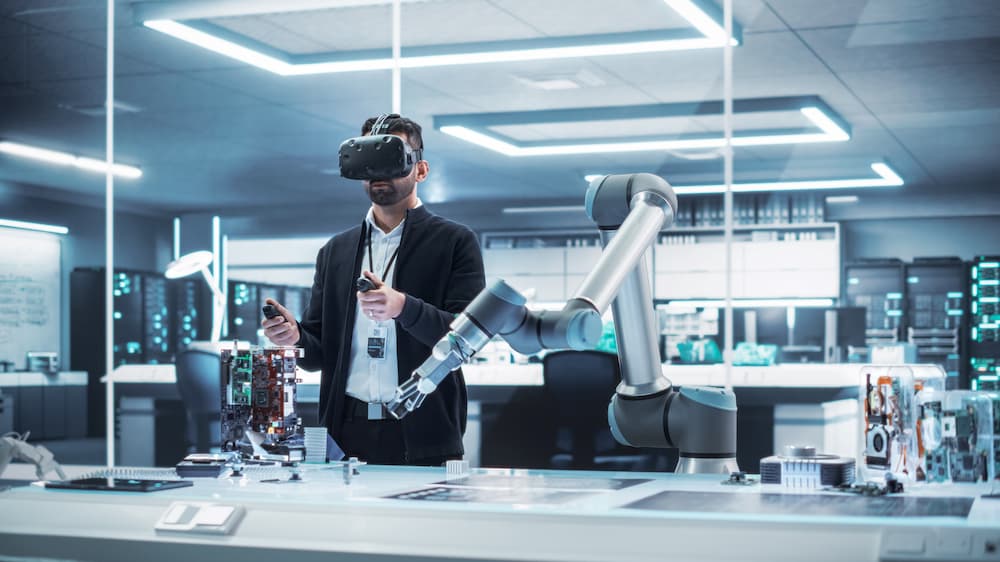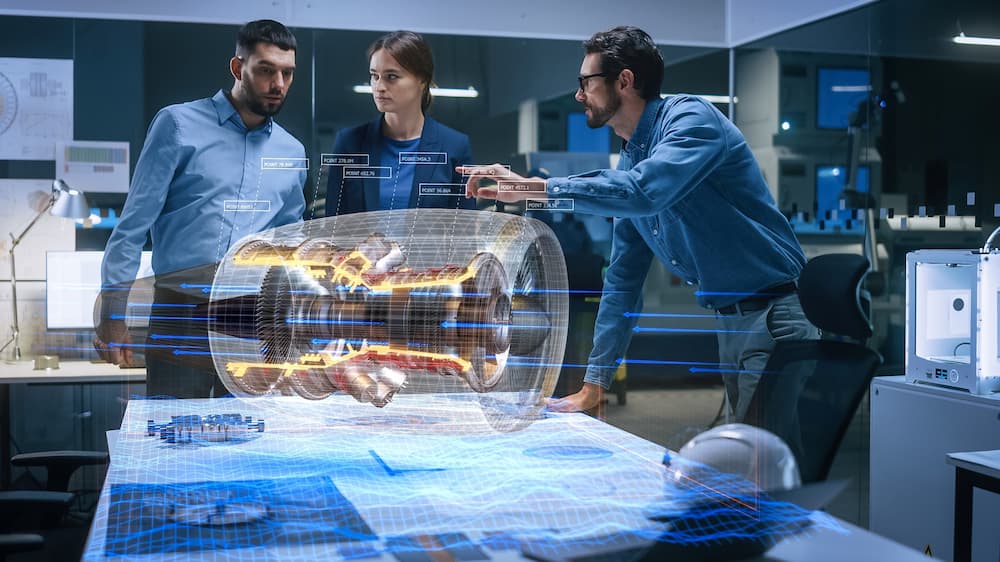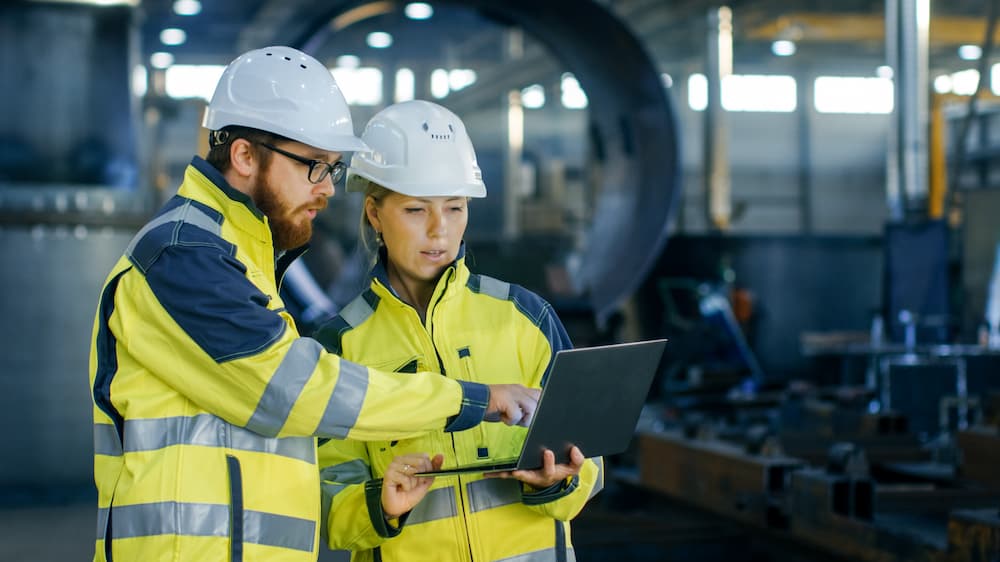From Virtual to Valuable: How the Industrial Metaverse is Revolutionizing Manufacturing
Fujitsu / August 5, 2025
Cutting-edge technologies are revolutionizing how manufacturers operate, train their workforce, and even design their products. The industrial metaverse isn't just about futuristic VR demos – it's about tangible improvements in efficiency, safety, and innovation that are transforming the manufacturing landscape today.
For decades, manufacturers have strived for optimization, but the Industrial Metaverse offers an unprecedented leap forward. It's creating a seamless bridge between the physical and digital worlds, enabling unprecedented levels of data integration, real-time collaboration, and predictive intelligence. This isn't a distant future. It's a present opportunity for those ready to embrace it. In this article, we delve into the foundational concepts, the enabling technologies, and the practical strategies for integrating the Industrial Metaverse into your operations, ensuring you're not just keeping pace, but leading the charge.
Contents
- Demystifying the Industrial Metaverse: Technologies Powering the Next Era of Manufacturing
- What’s driving interest in virtual tools across manufacturing operations today?
- The Human element: The key for successful implementation
- Building a Strong Foundation
- Fujitsu: Guiding your journey to the Industrial Metaverse

Demystifying the Industrial Metaverse: Technologies Powering the Next Era of Manufacturing
At its core, the industrial metaverse is a digitally connected environment that seamlessly blends physical industrial systems with virtual and augmented realities. This powerful combination enables real-time collaboration, simulation, and optimization across the entire industrial value chain. Think of it as a digital mirror reflecting and enhancing your physical operations.
So, what technologies fall under the industrial metaverse umbrella? Here are a few key players:
• IoT Integration: Real-time data from physical sensors feeds directly into the virtual environment, providing up-to-the-minute insights into machine performance, environmental conditions, and more.
• Digital Twins: These virtual replicas of physical assets allow for predictive maintenance through simulated machine behavior. Imagine being able to foresee potential equipment failures before they happen, minimizing downtime and maximizing productivity.
• Virtual Factory Design and Layout Planning: Design and optimize your factory layout in a virtual environment, experimenting with different configurations without the cost and disruption of physical changes.
• AI-Driven Supply Chain Resilience: Solutions like the collaboration between Fujitsu and Palantir leverage data integration, generative AI, and digital twin simulations to enable scenario-based supply chain resilience. This allows manufacturers to prepare for and mitigate disruptions proactively.

What’s driving interest in virtual tools across manufacturing operations today?
Virtual tools are no longer a futuristic concept – they're a practical necessity. Manufacturers are under increasing pressure to build smart factories that are more efficient, agile, resilient, and responsive to ever-changing market demands. This translates into tangible benefits:
• Economic Pressure and Cost Reduction: Reduced prototyping costs, optimized operations, and predictive maintenance all contribute to significant cost savings.
• Increased Productivity and Efficiency: Real-time monitoring and analysis, accelerated product development, and virtual commissioning lead to faster time-to-market and increased output.
• Enhanced Quality and Innovation: Improved product and process design, coupled with mass customization capabilities, drive innovation and higher quality products.
• Workforce Transformation and Safety: Immersive training programs, remote assistance, and enhanced employee engagement create a safer and more productive work environment.
• Supply Chain Resilience and Visibility: Improved supply chain planning and risk mitigation ensure business continuity and minimize disruptions.
• Sustainability Goals: Virtual tools can help track CO2 emissions, optimize energy efficiency, and reduce waste, contributing to sustainability initiatives.
Companies are increasingly investing in industrial metaverse technologies and seeing substantial returns, with many reporting positive ROI within 12 to 24 months.

The Human element: The key for successful implementation
While technology is powerful, successful implementation requires a focus on the human element. Training and re-education of the manufacturing workforce are often overlooked but are critical for success.
• Don't Assume "Digital Natives" = Digitally Capable: Many operators, especially in legacy environments, may not be comfortable with new tech, even if they use smartphones.
• Change Management is Key: Tech rollouts should focus on the people, not just the hardware/software. Address cultural barriers, fears of job displacement, and clearly communicate the benefits for each individual.
• Tailor Training: Learning curves vary widely. Tailor training to different roles and comfort levels to maximize adoption and minimize resistance.

Building a Strong Foundation
To truly unlock the value of virtual tools, manufacturers need a strong digital foundation that is connected, automated, intelligent, and secure. This includes:
• Data Infrastructure: A robust system for collecting, storing, and managing data from various sources.
• Sensors: Deploying sensors to capture real-time data from physical assets.
• Cloud and Edge Computing: Leveraging cloud and edge computing to process and analyze data efficiently.
Learn more about laying the right foundation for Manufacturing success in this Blog Article.

Fujitsu: Guiding your journey to the Industrial Metaverse
Fujitsu stands out in the industrial metaverse space because of its human-centric, co-creative approach to digital transformation. With deep manufacturing expertise, strategic partnerships, and an enterprise-ready platform ecosystem, we help manufacturing leaders scale virtual tools from pilot projects to achieve significant impact.
Offering a unique blend of industrial insight, platform flexibility, and a people-first approach, Fujitsu enables manufacturers to become more agile, efficient, and sustainable through the industrial metaverse.
Here are some of our Industrial Metaverse capabilities and solutions to drive your manufacturing innovation:
• Digital Twin & Simulation: Implement real-time digital twins to enhance the efficiency of production lines, optimize complex supply chains, and improve energy management.
• AR/VR & Immersive Operations: Transform workforce training and operational execution with augmented reality-guided work instructions and virtual reality-based immersive learning environments.
• AI/ML for Predictive & Prescriptive Analytics: Utilize advanced AI and Machine Learning models to enable predictive maintenance, minimize downtime, and perform in-depth root cause analysis.
• AI-Enhanced Supply Chain Simulation (with Palantir): Partnering with Palantir, we provide dynamic supply chain control towers and powerful scenario-based planning for resilient and responsive operations.
• Smart Factory Modernization: Achieve a truly agile manufacturing environment through the seamless integration of MES/ERP/SCADA systems with scalable, cloud-native control layers.
• Sustainable Manufacturing Solutions: Support your sustainability goals with precise CO₂ tracking and intelligent energy efficiency models, contributing to a greener footprint.
Ready to turn vision into value? Connect with our Fujitsu Expert to integrate the Industrial Metaverse into your factory.

Johan inspires our customers to think of new ways of applying technology to traditional business functions and revolutionize the way they operate to increase productivity and prepare for the future.
Editor's Picks



